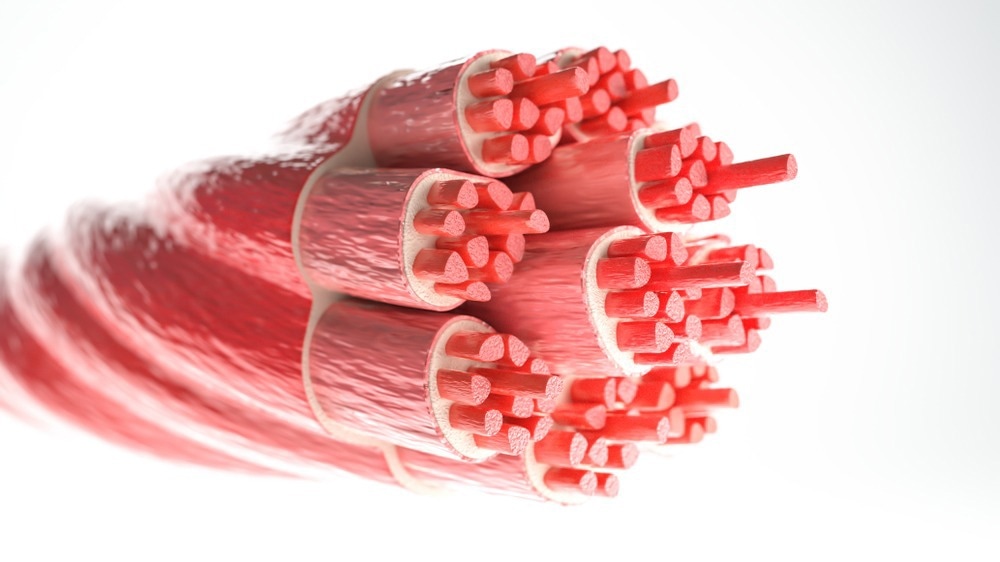Developing lightweight and robust smart textiles is an emerging need to meet the demand for skin-conformable wearable devices. Designing wearable devices inspired by muscle fibers could serve as valuable contributions to next-generation electronics.

Study: Muscle Fibers Inspired Electrospun Nanostructures Reinforced Conductive Fibers for Smart Wearable Optoelectronics and Energy Generators. Image Credit: Crevis/Shutterstock.com
An article recently published in the journal Nano Energy discussed the reinforcement of wearable devices with conductive nanofibers to achieve mechanical and electronic robustness.
Mechanically robust and strain-insensitive electrospun reinforced conductive fiber (ERCF) electrodes consist of mechanical reinforcements (with nanofibers) which are amenable along with silver nanoparticles (AgNPs) that are deeply adhered, leading to wearable devices with high durability. The strain-insensitive ERCFs that can be processed in a solution at room temperature exhibit electrical tolerance in hysteresis-free smart gloves, light-emitting electrochemical cells (LECs), and established human-computer cognitive interfaces that are utilized in wearable devices.
The ERCF-based nanogenerator yielded high current, piezoelectric voltage, and power output values, thus overcoming the issues of cost, toxicity, non-biocompatible dopants, and high energy requirements. Thus, smart sensors and wearable devices integrated with nanofibers could be utilized in healthcare applications via remote communication.
Nanofibers in Wearable Devices
Nanofibers have a diameter range from 1 to 1000 nanometers and are generated from polymers, including natural and synthetic materials. These polymers used for producing nanofibers need to possess high molecular weight, have few and small side chains, and should thoroughly dissolve in specific solutions and conditions.
Nanofibers have found numerous applications in the optics and electronics fields due to their customizable physicochemical characteristics, such as the large surface area to volume ratio, flexibility, being lightweight, and small diameter and small pore size. Hence, nanofibers have potential applications in wearable devices.
Construction of next-generation wearable devices involves skin-mimicking materials to realize the integration of these devices without using adhesives. The primary concern of researchers working on wearable devices is to improve their vital aspects, including flexibility, stretchability, durability, and stability at room temperature.
To this end, extensive research was previously conducted to attain wearable devices with high durability and electrical performance with good stability. Moreover, additional efforts were made to decrease the vulnerability of wearable devices to electrode failure. Reinforcing the smart textiles with nanofibers having high conductivity and stretchability is the most reliable approach to integrating other active components. Moreover, controlling the aspect ratios of nanofibers and interface modification with these nanofibers can help develop smart wearable devices.
Despite the flexibility and compatibility of piezoelectric polymers with human skin, the limitations due to the energy-intensive poling process and electroactive β-phase evolution restrict the biomechanical energy harvesting and commercialization. The mechanical robustness, non-toxicity, comfort, and robustness in wearable devices can be achieved by enhancing the electroactive β-phase by doping with various organic and inorganic dopants.
Electrospun Nanofibers Reinforced Conductive Fibers
In the present study, the fabrication of mechanically robust, highly stretchable, muscle fiber-inspired ERCFs was described. The ERCFs were composed of electrospun polymeric styrene–butadiene–styrene (SBS) nanofibers and AgNPs. The nanofibers containing ERCFs had the potential application in wearable devices or electrodes with stain-resistant electrical conductivity, LECs, smart gloves, and self-powered textile-based piezoelectric generators.
The excruciating mechanical reinforcements strongly attached conductive fibrous structures (owing to reinforcement with nanofibers), electromechanical stability due to energy dissipation endow the wearable devices with stain-resistant conductivity without the need for vacuum, complex patterning, or photolithography methods.
The nanofibers containing ERCF-based smart gloves revealed that the human-machine interfaces that are hysteresis-free could be integrated effectively into the next-generation Internet of things (IoT) via 5G data communication systems. Moreover, wearable-fiber LECs that are solution-processed at room temperature exhibited outstanding luminescent characteristics.
The piezoelectric energy generation with strain-insensitivity was observed to be achieved by creating a dopant-free self-poled electrospun twisted polyvinylidene fluoride (PVDF) which enabled the generation of sustainable energy under a voltage of 29.5 volts and power of 11.57 microwatts. Additionally, this twisted PVDF showed scalability, cost-effectiveness, breathability, and durable performance.
Conclusion
In summary, two methods of stretchable electrode fabrication were proposed, namely electrospinning and wet spinning. The nanofibers containing ERCFs showed outstanding strain-insensitive conductivity, mechanical robustness, and recoverability due to the combined effects of adhesion of AgNPs, reinforcement of nanofibers, and energy distribution.
Wearable devices like designed smart gloves based on nanofibers containing ERCFs enabled hysteresis-free electric responses. This could be integrated with communication devices (assisted by mobile phone) and smart watches and in other next-generation healthcare diagnostics. Additionally, the LEC devices based on ERCFs are a breakthrough in wearable device fabrication with solution-processability and advantageous luminescent characteristics under room temperature.
The electrospun nanofibers in energy harvesting experiments promoted β-phase enhancement and self-poling behavior, which induced piezoelectric energy generation irrespective of wind force. Breathable, fibrous, energy-harvesting, and sustainable devices with phase–enhanced piezoelectric ERCF/PVDF/Ag nanowires (ESNGs) could achieve high performance even under deformations and result in greater output.
Reference
Veeramuthu, L., Cho, CJ., Venkatesan, M., Kumar, R G, Hsu, HY., Zhuo, BX., Kau, LJ, et al. Muscle Fibers Inspired Electrospun Nanostructures Reinforced Conductive Fibers for Smart Wearable Optoelectronics and Energy Generators. Nano Energy. https://doi.org/10.1016/j.nanoen.2022.107592
Disclaimer: The views expressed here are those of the author expressed in their private capacity and do not necessarily represent the views of AZoM.com Limited T/A AZoNetwork the owner and operator of this website. This disclaimer forms part of the Terms and conditions of use of this website.